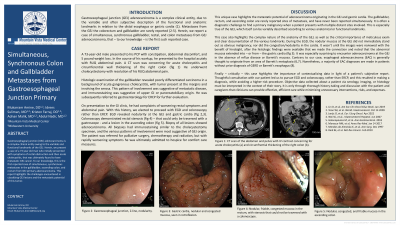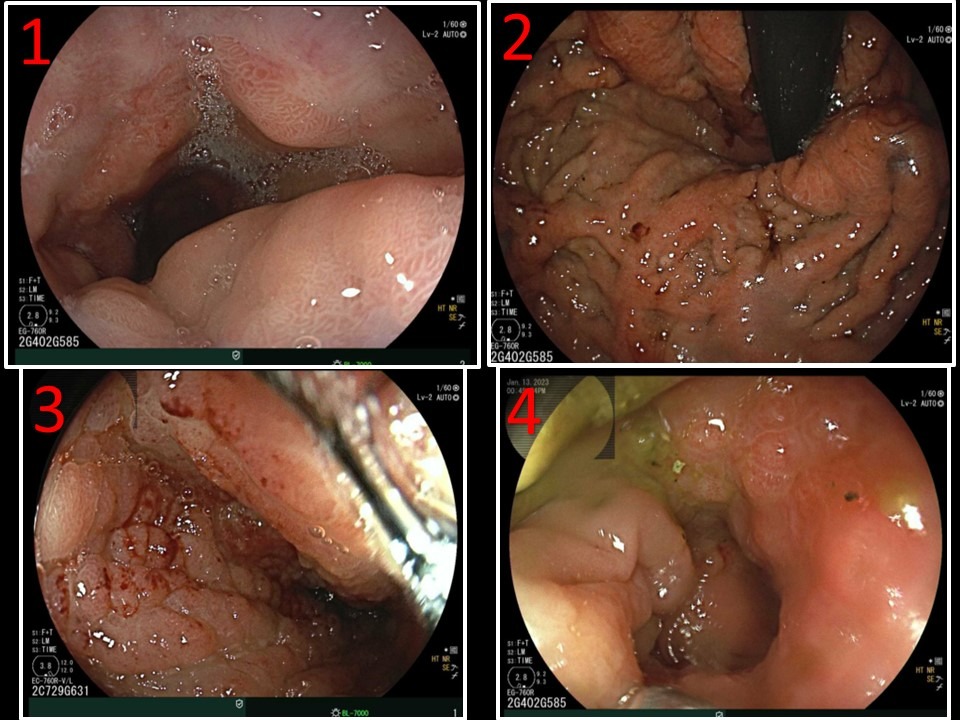Monday Poster Session
Category: Esophagus
P1867 - Simultaneous, Synchronous Colon and Gallbladder Metastases from Gastroesophageal Junction Primary
Monday, October 23, 2023
10:30 AM - 4:15 PM PT
Location: Exhibit Hall

Has Audio
- MA
Mukarram Amine, DO
Midwestern University
Mesa, Arizona
Presenting Author(s)
Mukarram Amine, DO1, Idrees Suliman, MD1, Kristen Farraj, DO2, Adnan Malik, MD1, Abdul Nadir, MD3
1Midwestern University, Mesa, AZ; 2Midwestern University, Chandler, AZ; 3Mountain Vista Medical Center, Mesa, AZ
Introduction: Gastroesophageal junction (GEJ) adenocarcinoma is a complex clinical entity, due to the variable and often subjective description of the functional and anatomic landmarks in relation to the distal esophagus or gastric cardia. Metastases from any of these primary sites to the colorectum and gallbladder are rarely reported. Herein, we report a case of simultaneous, synchronous gallbladder, rectal, and colon metastases from GEJ adenocarcinoma, that – to our knowledge – is the first such reported case.
Case Description/Methods: A 73-year-old male presented to his PCP with constipation, abdominal discomfort, and 5 pound weight loss. In the course of his workup, he presented to the hospital acutely with RUQ abdominal pain. A CT scan was concerning for acute cholecystitis and circumferential wall thickening of the right colon. He underwent cholecystectomy with resolution of his RUQ abdominal pain.
Histologic examination of the gallbladder revealed poorly differentiated carcinoma in a background of acute gangrenous cholecystitis, with tumor present at the margins and involving the serosa. This pattern of involvement was suggestive of metastatic disease, and immunostaining was suggestive of upper GI or pancreatobiliary origin. He was subsequently referred to gastroenterology.
On presentation to the GI clinic, he had complaints of worsening rectal symptoms. He underwent EGD and colonoscopy. EGD revealed nodularity at the GEJ and gastric cardia (fig 1,2). Colonoscopy demonstrated rectal stenosis (fig 3) – that could only be traversed with a gastroscope - and a lesion in the ascending colon (fig 4). Biopsy of all lesions showed adenocarcinoma. All biopsies had immunostaining similar to the cholecystectomy specimen, and the various patterns of involvement were most suggestive of GEJ origin. The patient was referred for palliative surgery, chemotherapy and radiation, but with rapidly worsening symptoms he was ultimately admitted to hospice for comfort care measures.
Discussion: This unique case highlights the metastatic potential of adenocarcinoma originating in the GEJ and gastric cardia. The gallbladder, rectum, and ascending colon are rarely reported sites of metastasis, and have never been reported simultaneously. It is often a diagnostic challenge to find a primary malignancy when a patient presents with multiple distant sites involved. This is especially true of the GEJ, which itself can be variably described according to various anatomical or functional landmarks.

Disclosures:
Mukarram Amine, DO1, Idrees Suliman, MD1, Kristen Farraj, DO2, Adnan Malik, MD1, Abdul Nadir, MD3. P1867 - Simultaneous, Synchronous Colon and Gallbladder Metastases from Gastroesophageal Junction Primary, ACG 2023 Annual Scientific Meeting Abstracts. Vancouver, BC, Canada: American College of Gastroenterology.
1Midwestern University, Mesa, AZ; 2Midwestern University, Chandler, AZ; 3Mountain Vista Medical Center, Mesa, AZ
Introduction: Gastroesophageal junction (GEJ) adenocarcinoma is a complex clinical entity, due to the variable and often subjective description of the functional and anatomic landmarks in relation to the distal esophagus or gastric cardia. Metastases from any of these primary sites to the colorectum and gallbladder are rarely reported. Herein, we report a case of simultaneous, synchronous gallbladder, rectal, and colon metastases from GEJ adenocarcinoma, that – to our knowledge – is the first such reported case.
Case Description/Methods: A 73-year-old male presented to his PCP with constipation, abdominal discomfort, and 5 pound weight loss. In the course of his workup, he presented to the hospital acutely with RUQ abdominal pain. A CT scan was concerning for acute cholecystitis and circumferential wall thickening of the right colon. He underwent cholecystectomy with resolution of his RUQ abdominal pain.
Histologic examination of the gallbladder revealed poorly differentiated carcinoma in a background of acute gangrenous cholecystitis, with tumor present at the margins and involving the serosa. This pattern of involvement was suggestive of metastatic disease, and immunostaining was suggestive of upper GI or pancreatobiliary origin. He was subsequently referred to gastroenterology.
On presentation to the GI clinic, he had complaints of worsening rectal symptoms. He underwent EGD and colonoscopy. EGD revealed nodularity at the GEJ and gastric cardia (fig 1,2). Colonoscopy demonstrated rectal stenosis (fig 3) – that could only be traversed with a gastroscope - and a lesion in the ascending colon (fig 4). Biopsy of all lesions showed adenocarcinoma. All biopsies had immunostaining similar to the cholecystectomy specimen, and the various patterns of involvement were most suggestive of GEJ origin. The patient was referred for palliative surgery, chemotherapy and radiation, but with rapidly worsening symptoms he was ultimately admitted to hospice for comfort care measures.
Discussion: This unique case highlights the metastatic potential of adenocarcinoma originating in the GEJ and gastric cardia. The gallbladder, rectum, and ascending colon are rarely reported sites of metastasis, and have never been reported simultaneously. It is often a diagnostic challenge to find a primary malignancy when a patient presents with multiple distant sites involved. This is especially true of the GEJ, which itself can be variably described according to various anatomical or functional landmarks.

Figure: Figure 1: Gastroesophageal junction, Z-line, nodularity..
Figure 2: Gastric cardia, nodular and congested mucosa, seen in retroflexion.
Figure 3: Nodular, friable, congested mucosa in the rectum, with stenosis that could not be traversed with a colonoscope.
Figure 4: Nodular, congested, and friable mucosa in the ascending colon.
Figure 2: Gastric cardia, nodular and congested mucosa, seen in retroflexion.
Figure 3: Nodular, friable, congested mucosa in the rectum, with stenosis that could not be traversed with a colonoscope.
Figure 4: Nodular, congested, and friable mucosa in the ascending colon.
Disclosures:
Mukarram Amine indicated no relevant financial relationships.
Idrees Suliman indicated no relevant financial relationships.
Kristen Farraj indicated no relevant financial relationships.
Adnan Malik indicated no relevant financial relationships.
Abdul Nadir indicated no relevant financial relationships.
Mukarram Amine, DO1, Idrees Suliman, MD1, Kristen Farraj, DO2, Adnan Malik, MD1, Abdul Nadir, MD3. P1867 - Simultaneous, Synchronous Colon and Gallbladder Metastases from Gastroesophageal Junction Primary, ACG 2023 Annual Scientific Meeting Abstracts. Vancouver, BC, Canada: American College of Gastroenterology.
